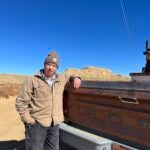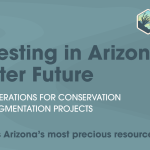Last week Governor Hobbs and the Arizona Department of Water Resources (ADWR) released a new analysis of groundwater in the Phoenix metro area. News broke around the country with headlines questioning the viability of future development in the region. But, what does this new analysis actually mean for Arizona? Let’s dive in.
What does this new analysis show, who is impacted?
The Assured Water Supply (AWS) program is a tool within the state’s Active Management Areas (AMAs), requiring new subdivisions to prove a 100 year water supply in order for homes to be sold. ADWR uses groundwater models in each AMA, including for the purpose of administering the AWS program.
This new analysis shows groundwater in the Phoenix area is now fully allocated, which will limit the ability of developers to use local groundwater to prove a 100 year assured water supply for new homes.
Impacts will fall on new subdivision development along the outskirts of the Valley, for example in areas like Buckeye and Queen Creek, that do not already have an AWS designation or certificate. New development within the water service areas of valley cities (or private water utilities) that already have AWS designations – for example Phoenix, Mesa, Scottsdale, Gilbert, and Tempe – will not be impacted.
There are ways for developers to get around these constraints. The AWS program only applies to new subdivisions, which are defined as having six lots or more. Lot-splitting is an approach sometimes used by developers to circumvent AWS requirements – leaving homeowners holding the bag should water run out. These “wildcat subdivisions,” such as Rio Verde which recently ran out of water, can still proceed. The AWS program also does not apply to build-to-rent homes. In Pinal County, for example, homebuilders are pursuing a build-to-rent approach in order to avoid AWS constraints.
What does this mean for growth?
Unbridled sprawl, sometimes referred to as the “building homes for the people building homes” approach to manufacture economic growth, was never sustainable. The water supply limits demonstrated by this new analysis make that point clear, and as a result, patterns of growth will likely shift over time.
The Kyl Center characterized the choice now faced with new development as, “Now developers will need to weigh developing on more expensive land within these service areas (that already have an AWS) against the cost of developing water supplies other than local groundwater.” In other words, growth in the Phoenix area could shift more inward (and upward) vs outward. Growth won’t stop, however it will likely look different over time.
What is the purpose of the AWS program?
The AWS program’s original intent was to shift new growth away from finite groundwater toward renewable water supplies, while providing consumer protection for homebuyers. To continue meeting this intent, the program is due to be strengthened by, for example, addressing lot splitting and build-to-rent loopholes, and by working through other reforms that have been recommended in order to ensure water stability in the region.
Big new water supplies from out of state will save us, right?
No. Importing water from out of state is decades out, at best. In-state opportunities to augment supplies are more viable, such as increasing storage on the Salt-Verde system (at least a decade out) and regional wastewater recycling infrastructure (several years out). Conservation, reuse, water exchanges, and carefully managing the water we do have — groundwater — is how we can ensure water security now and into the future.
Why was publicly releasing this groundwater analysis so important?
Transparency and providing the public access to honest information about our water supplies — versus sweeping inconvenient facts under the rug — is critical in order to craft meaningful solutions. The public release was an important signal that it’s time to get honest about our water challenges and serious about solutions.
How does the Colorado River factor into this?
Overuse and aridification have brought the Colorado River to the brink of tanking. Colorado River water users will need to use less water on a massive scale, across the board, to prevent the collapse of the river in the coming years. As the river shrinks, Arizona’s reliance on groundwater, which already accounts for over 40% of our state’s water supply, will increase.
This new analysis assumes Colorado River deliveries based on current agreements. New agreements, expected by 2026, will likely entail less Colorado River water deliveries to central Arizona year over year, presumably resulting in less recharge to the aquifer than currently assumed. The Phoenix AMA model will need to be adjusted in time to reflect new agreements, likely resulting in even tighter water supply constraints.
What about the rest of us, outside the Phoenix area?
Over about 80% of the state is home to a growing rural population of about 1.5 million people who live where there is no groundwater management — despite groundwater often being the only water supply. As a result, rural residents’ wells are drying up or under threat, local farms are going under, and our rivers are being depleted.
During a presentation last week by ADWR on the new Phoenix groundwater analysis, the final takeaway point was “people are not running out of water.” However, in rural Arizona, some communities are running out of water.
For example, over 100 residents in Willcox recently sent a letter to Governor Hobbs requesting executive action on groundwater management in their basin, citing the Legislature’s failure to provide alternative options. They stated: “Many of us have had to deepen our domestic wells at significant cost…Some of us have been unable to afford to drill a new deeper well and are now having water hauled to our homes…We know neighbors who have moved elsewhere because of the declining water table.”
While attention on Phoenix area water issues is needed, a number of rural communities face an immediate water crisis. For years, a growing number of rural communities have come to the Legislature seeking more options to protect local groundwater supplies, only to be ignored. Every Arizonan has a right to a water-secure future – whether they live in Phoenix, Kingman, Gilbert, or Willcox.
What comes next?
Governor Hobbs tasked her new Water Policy Council with making recommendations for legislation by December on both rural groundwater management and the AWS program.
For years, a small handful of special interests have worked to block progress on these water issues and have even shut down public dialogue in order to preserve the status quo of inaction. However, as a broader set of stakeholders, more community leaders, and new legislators engage, new possibilities open up.
It will take strong leadership from the Governor, legislative leadership, and state officials, in addition to new legislators willing to challenge the status quo of inaction in order to get solutions across the finish line. It will take courage. Arizonans are paying close attention and are expecting results — water is currently the #1 issue among Arizona voters.
There is no more important work in Arizona over the next several months. It’s time to roll up the sleeves.












